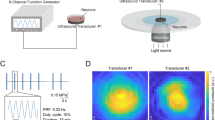Abstract
Using a voltage-clamp technique and intracellular dialysis, gating currents of sodium channels were first recorded and studied in neurons of the rat trigeminal ganglia. The rising phase of gating currents lasted 30 to 70 µsec; these currents decayed in a monoexponential manner with a time constant equal to that for activation of the sodium current. Voltage dependences for the gating charge and sodium conductance were also nearly identical. Analysis of the activation of sodium conductance demonstrated that the power n of the activation variable in the equation used changed from more than 6 to 3 at test potentials of −30 mV and 0 mV, respectively. It is hypothesized that, with a change in the test potential within this voltage range, the cooperativity of activation undergoes a twofold decrease. In the presence of 2 mM caffeine or theophylline in the external solution, curves of the voltage dependence of the gating charge and sodium conductance shifted toward more negative values of the test potential, by 5.4 ± 0.7 mV, the maximum gating charge increased by 8.4 ± 3.2%, and the slope factor for both curves decreased by 9.2 ± 3.4%. Since the above effects were identical for both xanthines and developed under conditions of constant intracellular dialysis, i.e., under conditions where the effect of a change in the intracellular calcium concentration was ruled out, the most probable reason for these effects is a direct action of the tested agents on sodium ion channels, which facilitates the movement of gating charges.
Similar content being viewed by others
REFERENCES
C. M. Armstrong and F. Bezanilla, “Currents related to movement of the gating particles of the sodium channels,” Nature, 242, 459–461 (1973).
W. Almers, “Gating currents and charge movements in excitable membranes,” Rev. Physiol. Biochem. Pharmacol., 82, 96–190 (1978).
F. J. Sigworth, “Voltage gating and ion channels,” Quart. Rev. Biophys., 27, 1–40 (1994).
P. G. Kostyuk, N. S. Veselovsky, and A. Ya. Tsindrenko, “Ionic currents in the somatic membrane of rat dorsal root ganglion neurons. 1. Sodium currents,” Neuroscience, 6, No.12, 2423–2430 (1981).
N. T. Parkhomenko and S. V. Mankevich, “Technique of the study of transmembrane currents of neurons in an automated mode,” Sechenov Fiziol. Zh., 71, No.12, 1638–1640 (1985).
A. L. Goldin, “Resurgence of sodium channel research,” Annu. Rev. Physiol., 63, 871–894 (2001).
P. G. Kostyuk and O. A. Kryshtal, Mechanisms of Electrical Excitability [in Russian], Nauka, Moscow (1981).
I. V. Tabarean and T. Narahashi, “Kinetics of modulation of tetrodotoxin-sensitive and tetrodotoxin-resistant sodium channels by tetramethrin and deltamethrin,” J. Pharmacol. Exp. Ther., 299, No.3, 988–997 (2001).
F. J. Sigworth, “The variance of sodium current fluctuations at the node of Ranvier,” J. Physiol., 307, No.1, 97–129 (1980).
N. G. Greef and F. J. P. Kuhn, “Variable ratio of permeability to gating charge of rBIIA sodium channels and sodium influx in Xenopus oocytes,” Biophys. J., 79, No.5, 2434–2453 (2000).
N. T. Parkhomenko, L. N. Yatsenko, and A. M. Kuksenok, “Agonistic effects of xanthines on tetrodotoxin-sensitive sodium channels in rat dorsal root ganglion neurons,” Neurophysiology/Neirofiziologiya, 29, Nos.4/5, 334–339 (1997).
C. M. Armstrong and W. F. Gilly, “Fast and slow steps in the activation of sodium channels,” J. Gen. Physiol., 74, No.6, 691–711 (1979).
R. D. Keynes and F. Elinder, “On the slowly rising phase of the sodium gating current in the squid giant axon,” Proc. Roy. Soc. Lond., Ser. B, 265, 255–262 (1998).
Y. Habuchi, H. Tanaka, T. Furukawa, and Y. Tsujimura, “Caffeine induced block of Na+ current in guinea pig single ventricular cells,” Am. J. Physiol., 261, No.6, Part 2, H1855–H1863 (1991).
N. Shirokova and E. Rios, “Caffeine enhances intramembranous charge movement in frog skeletal muscle by increasing cytoplasmic Ca2+ concentration,” J. Physiol., 493, No.2, 341–356 (1996).
J. Leroy, J. M. Lignon, F. Gannier, et al., “Caffeine-induced immobilization of gating charges in isolated guinea-pig ventricular heart cells,” Br. J. Pharmacol., 135, No.3, 721–734 (2002).
Author information
Authors and Affiliations
Corresponding author
Additional information
Neirofiziologiya/Neurophysiology, Vol. 36, Nos. 5/6, pp. 370–376, September–December, 2004.
Rights and permissions
About this article
Cite this article
Kostyuk, P.G., Parkhomenko, N.T. Gating currents of sodium channels in neurons of the rat trigeminal ganglia. Neurophysiology 36, 325–331 (2004). https://doi.org/10.1007/s11062-005-0026-2
Received:
Issue Date:
DOI: https://doi.org/10.1007/s11062-005-0026-2




